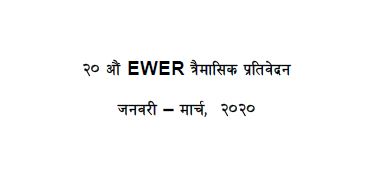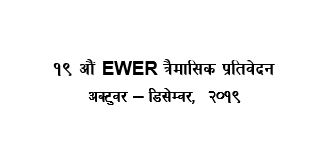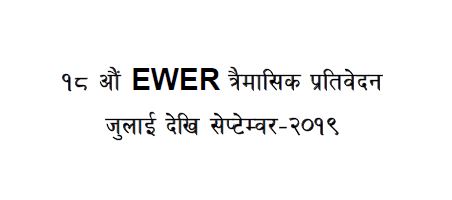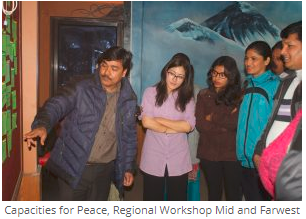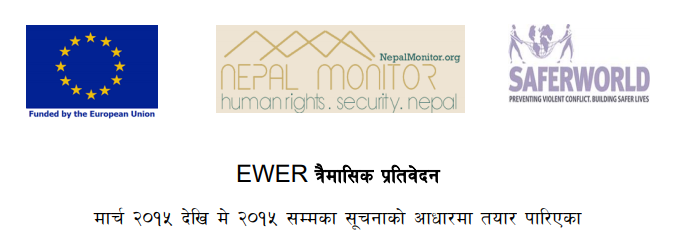Incident Reports
"How many times do we need to share our story?” Seulki Lee's Op-Ed on failures of Nepal’s peace process from a human rights perspective
2016-04-15
Bhumika Adhikari Gautam wiped her eyes silently in the dark while watching a video of testimonies by the victims of the conflict at a recent conference on truth and reconciliation in Kathmandu.
The film brought back memories of her own pain. One day, 14 years ago while coming home from school, she was taken in by an army patrol on suspicion of being a Maoist. She was detained at the base and raped repeatedly for three months.
“I felt their pain, I went through the same suffering as the rape victims in the film,” said Gautam, now 33.
After 12 years, the Supreme Court finally found the soldiers involved in Gautam’s rape guilty in 2014. But like in hundreds of other war crimes committed by both sides during the conflict, where perpetrators are known or even sentenced, they are still free.
“From the human rights perspective, Nepal’s peace process has been a failure,” states Mandira Sharma of the rights group, Advocacy Forum. “Except in one case, not a single perpetrator has been apprehended.”
Gaumati Gharti Magar’s husband was killed by the Maoists in Rolpa at the beginning of the conflict in 1996. Now 49, Magar joins every protest outside Singha Durbar with other conflict victims.
“We want to hear from the leaders of the Maoists why they had to use violence and kill innocent people like my husband only because he was from a different political party,” said Magar.
Gautam and Magar are exceptions among relatives of conflict victims because they can afford to travel to Kathmandu to seek justice. Most are too poor, or do not know how to work the system even to collect cash reparations.
As a result, in the past ten years after the end of the conflict, the movement for truth and justice has either been dominated by Kathmandu-based human rights organisations or donor-funded victims’ groups. They also tend to be top-down and politically polarised.
Since the former enemies are now the state (indeed, the Maoists have shared power with the NC and UML in several past coalition governments) Kathmandu has never been pro-active in pursuing the victims’ demands for truth and justice. The Truth and Reconciliation Commission (TRC) and the Commission of Investigation on Enforced Disappeared Persons (CIEDP) finally set up last year, have both been criticised for tokenism.
However, victims of violence by both sides have found common cause to struggle together for justice. The first cross-cutting conflict victims’ groups were formed in 2006 in Bardia and Lamjung and in 2008, the Conflict Victims Society for Justice was established in Kathmandu to seek transitional justice.
Two years ago, Ram Kumar Bhandari, whose father was disappeared by the Army, and Suman Adhikari, whose father was killed by the Maoists (see below), both in 2001 in Lamjung, set up the Conflict Victims’ Common Platform (CVCP).
“There was a lot of hope after the Comprehensive Peace Agreement in 2006, and we families of victims expected that the new elected government would work for truth and justice,” said Bhandari, who 15 years later still doesn’t know what happened to his father.
From 2009-2012, various victims’ groups were formed including the National Network of Families of Disappeared and Missing and the Social Campaign for Justice.
“It was a big time for victim’s movement because parliament was drafting a new constitution and victims from both sides worked together. We managed to bring cases to the Supreme Court,” Bhandari recalled.
Mainly supported by European donors and international rights groups, Nepali campaigners documented evidence of wartime atrocities and crimes. Advocacy Forum alone collected evidence in 122 cases against state officials or Maoist leaders for murder and enforced disappearances.
“But today there is a shocking silence in the international community and among human rights organisations,” Mandira Sharma says, pointing to the lack of interest in high-profile cases like the killings of Arjun Lama and Krishna Adhikari even after orders from Supreme Court.
Even after the death of Nanda Prasad Adhikari in 2014, during a prolonged hunger strike seeking justice for his son’s murder, there was little reaction within Nepal and outside.
Sharma believes that the victims’ movement which had been gaining traction with a nationwide network of families and vigorous advocacy has since 2012 been losing ground. The transitional justice process in Nepal has lost its way as internationals pulled back, and the state tried its best to defuse the demand for justice.
“Transitional justice is a political bargaining agenda,” explains Mohna Ansari, the member of National Human Rights Commission (NHRC). “That is why people had to wait for nine years to have two commissions.”
Ironically, loss of momentum on the victims’ movement coincided with the setting up of the TRC and CIEDP last year, both are headed by political appointees and activists say its work so far is mostly a whitewash.
Says Mandira Sharma: “Accountability should build confidence that the state supports truth and justice. At least try a high profile cases and bring perpetrators to justice, so people can believe there is rule of law in this country.”
National/Online Media
Related Reports
Transitional Justice / Conflict Victims / Kathmandu
Demonstration staged demanding to rectify TRC bill
August 04, 2023
Transitional Justice / Conflict Victims / Kathmandu
Police detain protesting armed conflict survivors in Kathmandu
April 18, 2023
Transitional Justice / Conflict Victims / Kathmandu
Conflict victims, police clash at New Baneshwar
April 18, 2023
Transitional Justice / Conflict Victims / Kaski
Conflict victims stage sit-in in Kaski demanding to make transitional justice bill victim friendly
March 31, 2023
Transitional Justice / Conflict Victims / Kathmandu
Conflict victims stage demonstration in Kathmandu demanding honorable justice
August 15, 2022
